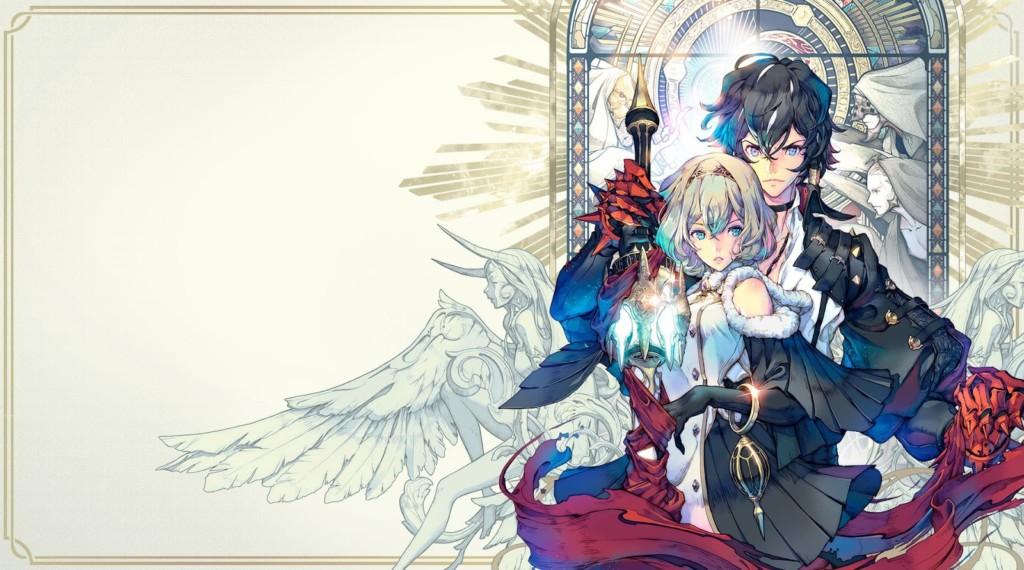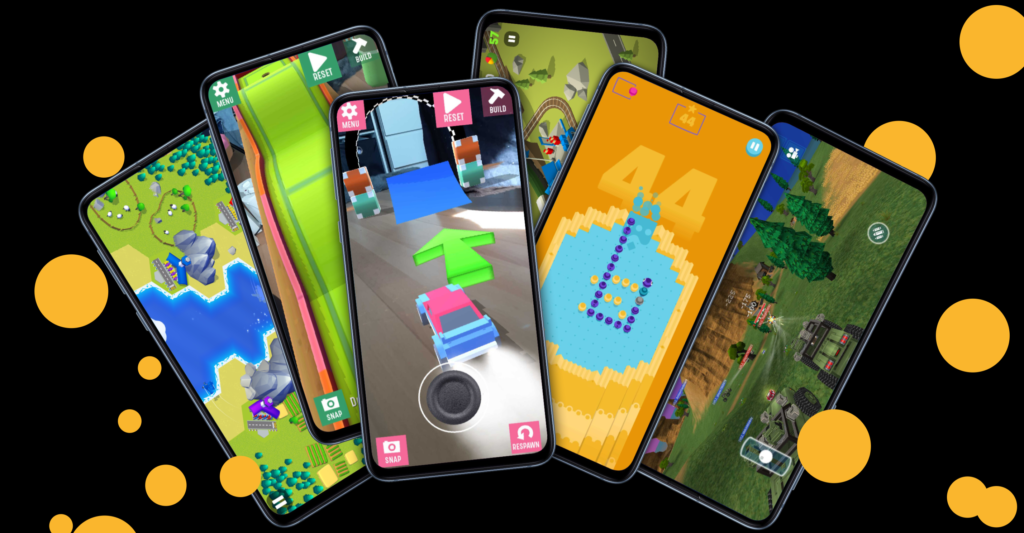Match 3 metamorphosis is real but doesn’t new territory often comes with new rules? Let’s dive deeper into where the game is afoot in these uncharted waters.
Editor’s note: This is a guest post by Om Tandon. Om is a UX Strategist, Leader & Mobile Games Consultant with 15+ years of holistic experience, building teams, processes, pipelines & creating massively entertaining & monetising experiences for worlds best known IP’s including Star Trek, Disney, 20th Century Fox, Hasbro, Marvel and many more.
This multi part analytical series is laser focused on what some of these new rules might be.
The previous analysis in this series looked at some historical data coupled with powerful tectonic forces of maturing player behaviour and deepening game design that has changed the lay of the land dividing the Match 3 landscape between Classic and Meta, ruled by the King’s and Playrix’s of the world.
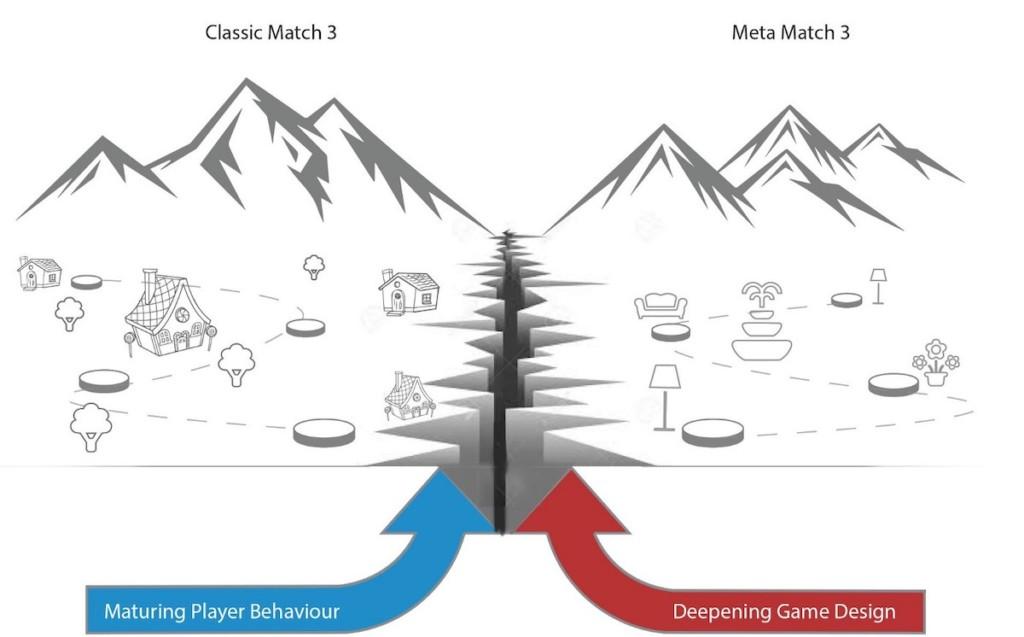
Yes, we are standing at a fork in the road folks but the real question is what does the road ahead looks like?
What is happening in the Classic Match 3 ringside?
King is hard at work defending it’s turf and legacy, rejuvenating & re-inventing it’s long reining and hugely popular Classic Match 3 franchise: Candy Crush Saga.
Candy Crush Saga today is unarguably a much different beast than its original avatar 8 years ago.
King, reading the current meta trends, has successfully introduced a multitude of secondary meta goals and events which actually do more than just re-inventing the wheel by refreshing game’s core and user experience. This depth is evident in their new level designs too.
Below you can see a variety of events and meta goals that players could chase while crushing candies.
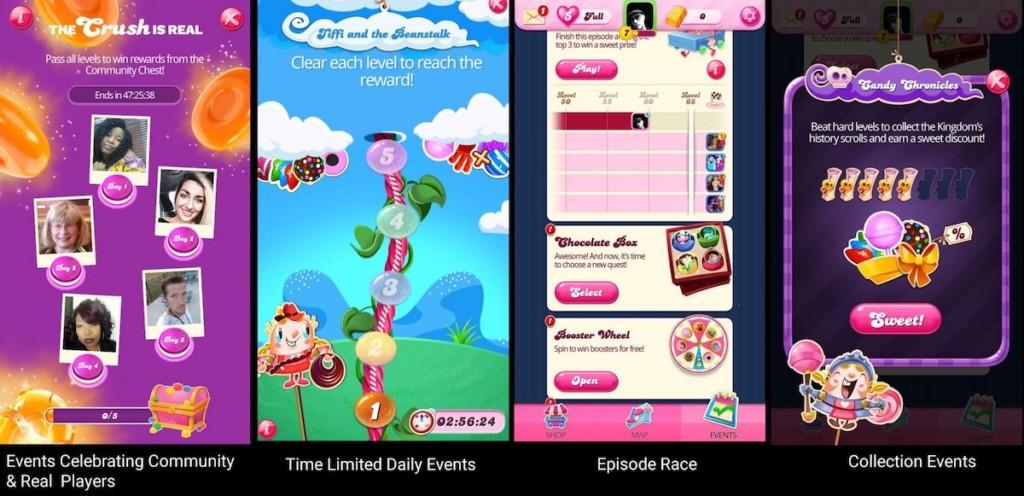
- Social proof & community engagement events around real players (Note: Normally most women cast are 35+ years, implying super engaged group are moms above 30 years of age). Which raises a question, is adoption among younger audiences declining?
- Time limited event levels like climbing up a bean stalk
- Leaderboard races against a limited group of friends (A small pool to ensure players have a good chance of ranking high with less effort. Example: Rank 8 out of 20 is much more motivating then rank 8000 out of 10,000 players)
- Scroll collection events to earn special offers
These features are soft-bodied versions of the gameplay seen in mid-core and hard-core games, but the question is: are these stopgap measures enough?
While the addition of these meta goals is refreshing and a welcome change, there can be some potential issue as newer mechanics & features are incrementally added over time:
- Lack of variable & sufficiently distinct rewards:
While an army of different event types and reward feature create variation in how players experience the game creating short, mid and long term progression arcs in CCS, the bummer is…
The rewards players get awarded for their efforts seem to be highly repetitious and can feel more or less same over time.
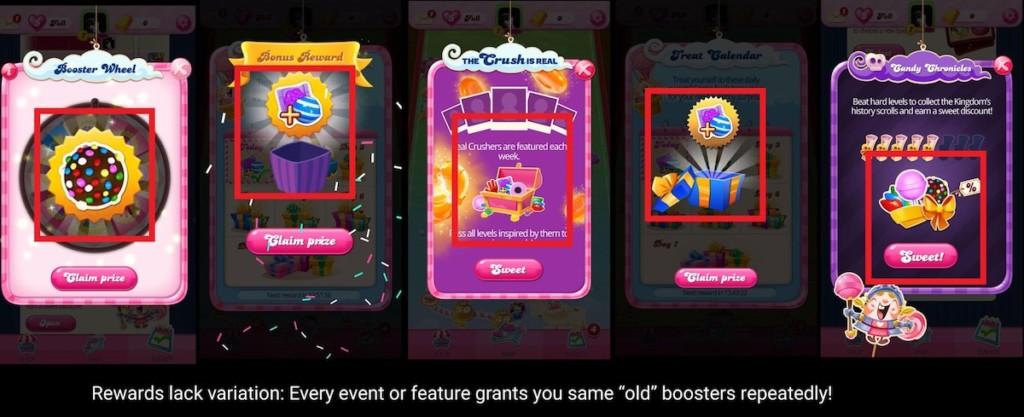
The images above shows different rewards a player can get for completing different events and meta goals in CCS and it’s quite obvious at a glance that majority of them are all too familiar boosters or bundles of those boosters.
All rewards are boosters & all boosters feel “kind of” same in Candy Crush Saga
Don’t get me wrong, boosters on their own are great, I especially love all the cool fireworks and animation effects they trigger (which are hallmark of King games and nobody does them better then King!)…but players get all too familiar with these boosters as they get them regularly for free as samplers in daily rewards (spinning wheel), many like chocolate bomb or jelly fish commonly appear on the game board as part of the cascades. In fact, when players get used to and can easily anticipate what they are going to get at the end of their tasks, it leads to lower dopamine surge and dilution of reward feeling.
In CCS players get more or less the same rewards wether they grind for short, mid and long term goals like events or collection features. This can massively dilute the value of rewards over time.
Impact of predictable and common rewards over time dopamine surge.
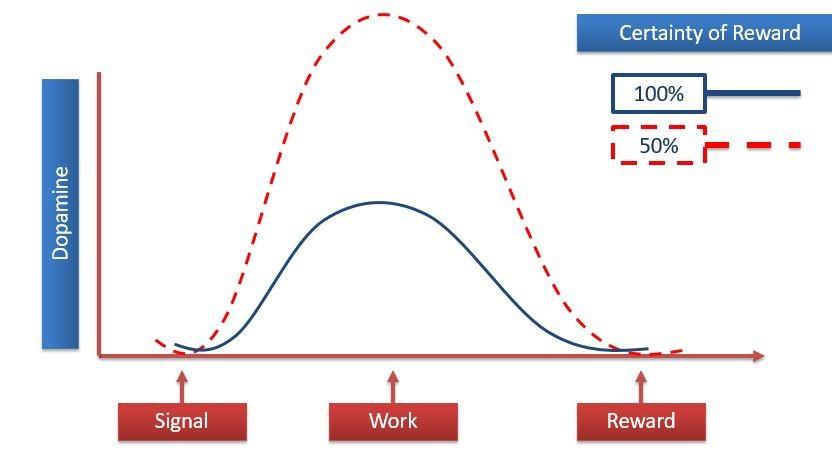
2. Lack of rarity systems in consumables or boosters:
Rewards in CCS at the moment lack a rarity system:
While consumables can be a good reward system, at present in CCS many don’t have a distinct identity or rare availability like the “Mighty Eagle” in the original Angry Birds.

Do you remember the hard to unlock “Mighty Eagle” in original Angry Birds? It was a booster that had real identity because of its rarity and all encompassing power. None of the boosters in CCS command that kind of identity. Combining this with frequency with which they are commonly dropped makes them far more commonplace as far as perceived value is concerned in the players mind, especially for veteran players.
3. Archaic single currency economy limits rewards to strictly “boosters”
CCS being one of the oldest Match 3 games out there is based on a single premium currency economy (gold bars). This is part of the reason why reward for almost every single action in the game boils down to boosters. On comparison, every new meta entrant has at least 2 currencies in addition to boosters that help add more depth and variety to reward distribution and grinding aspects of the game.

Consumable vs Currencies
Let’s look at some pros and cons of using currencies and consumable as rewards systems.
While both consumables and currencies have their pros and cons like subjective value, inflation etc, if you are going to have a wide variety of features along short term, mid term and long term progression arcs, then you have to give players more choice and variety. A reward system needs to be able to scale well either through rarity (common, rare to legendary) or variety in currency. Both have good potential for improvement in CCS.
King will most likely keep scaling meta goals along progression arcs but not scaling the reward system due to lack of rarity or being stuck with a single currency economy has the potential to dilute player motivation.
While time will tell, how players appreciate these efforts in the long run, given King is leaving no stone unturned in it’s quest to redefine & preserve classic Match 3, new entrants in Classic Match 3 are still going to have a tough time in the race to the top as the barrier to entry is still quiet high.
Now, let’s see what’s happening in the Meta Ringside

Reaching the top of this peak is also a steep climb if not impossible, given the aggressive dominance of early adopters and the genre becoming a hotbed of M&A activity.
Meta Match 3: Barriers to entry
- Hyper competitive nature of early adopters like Playrix with their aggressive marketing & UA war chest. Example: A recent spike in UA spend by Playrix’s competitors brought out a more than proportional response.
Don’t poke the Russian Bear, as noted by Deconstructor of Fun



Source: Deconstructor of fun
Chances are if you frequently play mobile games or browse facebook, you would have seen the ad below:

From Playrix’s aggressive & out-of-proportion rapid responses, it is clear any future attempts might be met with similar counter measures.
2. AppLovin‘s opting for vertical integration between a data analytics platform and game studios (Belka, Firecraft) created a strong alliance that marries the industry’s 360 degree wide panoramic data with the ability to execute learnings in its own games. This is a powerful strategy which might pay huge dividends.
3. Latest acquisition of Peak games (Toon Blast, Toy Blast) by Zynga adds more muscle and scaling ability for Peak via Zynga’s extensive network, especially in the areas of data science as mentioned by Frank Gibeau.
If the picture above looks bleak, fear not. There is always a way around as developers wet their feet into uncharted territories – mixing, mashing & experimenting to crack the Match 3 code…
In the analysis below, we will look at how the pie is getting divided even further. How far the meta in Match 3 can be pushed when combined with IP and audiences that fall outside the Classic Match 3 realm. One such example is the:
Property Brothers: Genre blending for a more matured audience
Making it’s way slowly but noticeably on the top grossing puzzle games chart is Storm 8’s Property Brothers Home Design
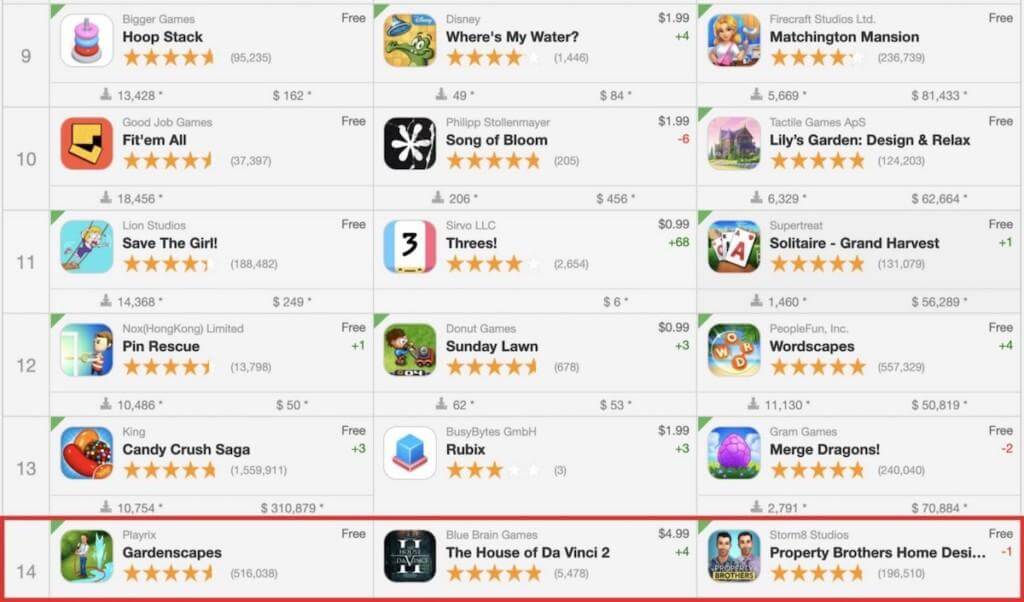
Source: Sensor Tower
Storm 8 History
Property Brothers from Storm 8’s stable is another take on “Match 3 with meta” which has been silently climbing the charts. While it has all the ingredients of now trending decorative meta, narrative driven gameplay, collapse core, it is really going after a different audience than Homescapes, Gardenscapes and Lily’s Garden. While all these games have casual fiction based cartoon narrative style, emphasis in Property Brothers is more on realistic decoration and fact driven narrative in a real world settings.
Property brothers goes after a more realistic decoration meta combining it with a popular real-world IP
The IP Factor
Property Brothers home design is based on a very popular reality television Canadian TV show where twin brothers Jonathan and Drew Scott use their technical expertise to help potential home buyers renovate houses to their liking within a specific budget. On that note:
Despite attempts in the past, Match 3 and IP games have not seen stellar chart busting success at a massive scale. IP based puzzle games like Frozen Adventures and Temple Run have seen limited success in match 3 genre.
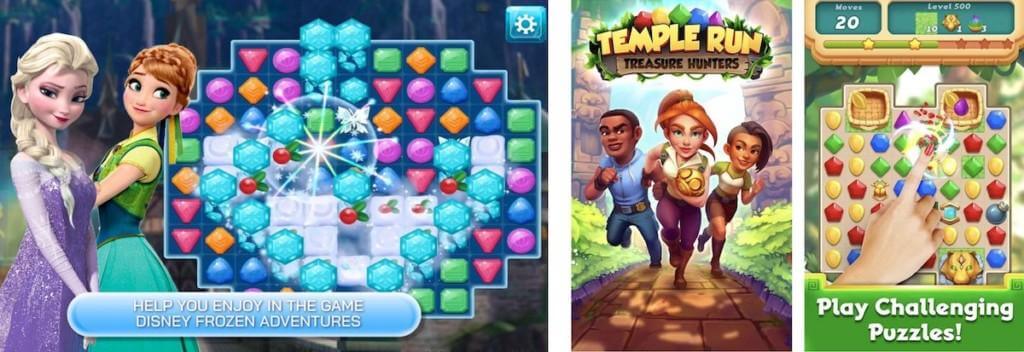
While IP and franchise tie ups have a chance of higher organic download from fan base, do not mistake it for a formula for success. After having worked for the last 15+ years on numerous chart busting IP led games (Star Trek, Ice Age, My Little Pony, Hardy Boys, Wizard of OZ, Alice in Wonderland etc), I can tell you with absolute certainty that IP alone will not carry your game to top of the charts.
Core gameplay needs to shine and cohesively blend with the IP universe, engaging franchise & non-franchise players alike to be able to reap rich rewards.
Property Brother Deconstruction: The Fusion Fiesta
With Property Brothers, Storm 8 is going after the hugely popular Glu Mobile’s Home Design audience who like realistic home decoration. Perhaps even eating Glu mobile’s lunch? 😉
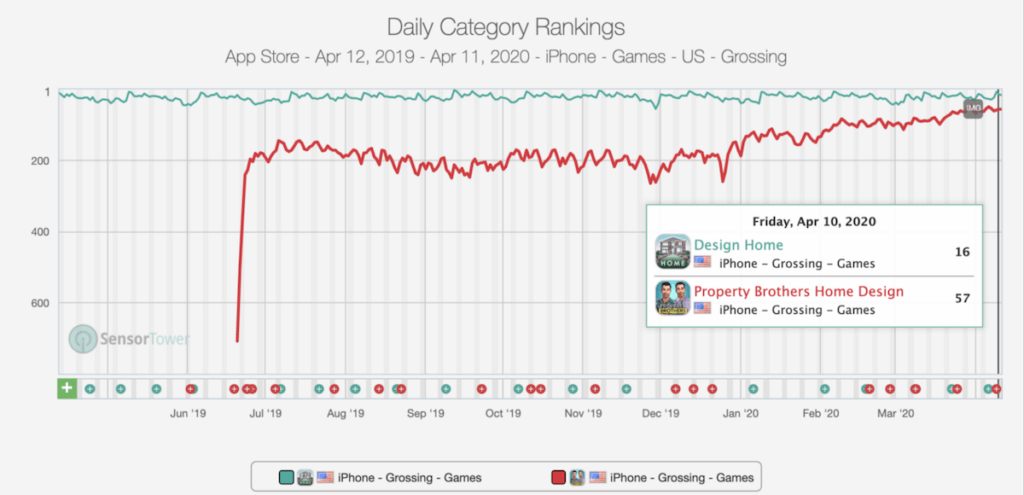
Source: Sensor Tower
Data above shows how Property Brother has been slowly closing the gap on Design Home since its launch in 2019 onto top grossing chart.
Storm 8 did it’s homework well when they shortlisted this IP. It’s a franchise hugely popular with women & baby boomers.


Property Brother’s (The TV show) market research demographics data above clearly indicates popularity with women (47%), millennials (age: 26-40 years) & baby boomers (age: 45+ years).
Now if we compare that data above with “Thinker” player archetypes form GameRefinery in meta Match 3 games below:
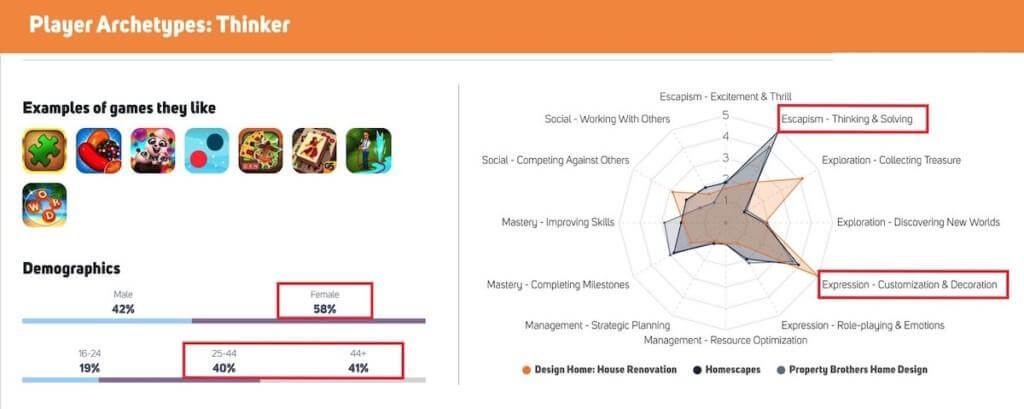
Source: GameRefinery
Property Brother’s IP audience overlaps very nicely with the demographics of Classic and Meta Match 3 games, which makes it a good fit for the genre.
The Core Loop
Property brothers takes all the successful ingredients of Meta Match 3 like well grounded characters, strong narrative, decoration challenges and tailors them for a more realistic art style and decoration-driven audience.
Property Brothers use the well established mental model of a TV show setting for fans while keeping the on-boarding simple & engaging for non franchise players
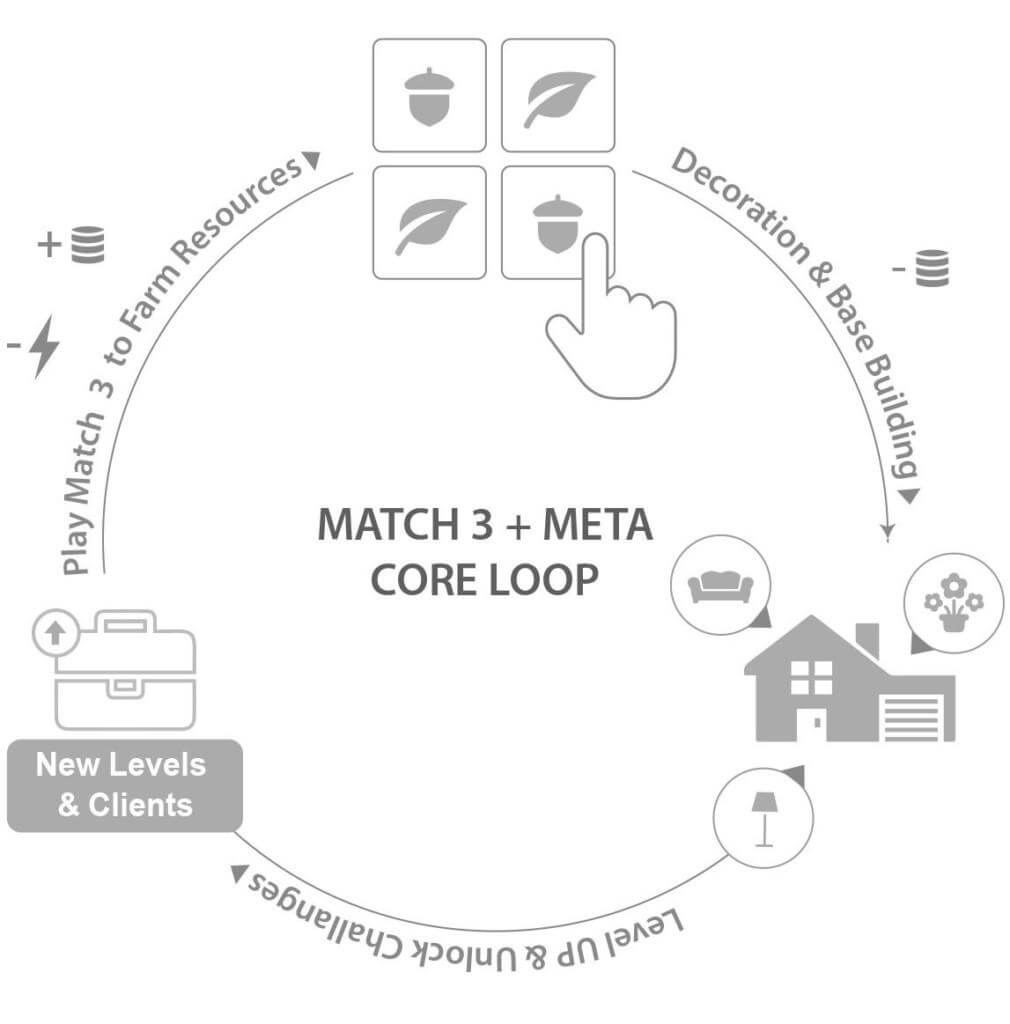
Core loop revolves around Property Brothers putting players in their own shoes and introducing the player to different clients. Player’s job is to decorate these properties using an aspirational blueprint vision which offers players some guidance but does not hinders their creative choices.
So far it sounds same as other decoration meta games, but there is a difference.
Property Brother offer way more choice in decoration meta and refreshed UX as players are not linearly restricted to just upgrading one home or one garden. The game offers a plethora of different homes to decorate for different clients. From living rooms to bed rooms to baby nurseries, a mind boggling variety to boot.

The Narration
Narration is a big part of Property Brother’s with the only caveat being compared to strictly indulging in a fictional story. Property Brothers introduce players to various characters in form of clients. The second big differentiation is:
Narration is not purely fiction as there are nuggets of interior design knowledge interspersed in the dialogues which is quite educational.

This mashing of interior design facts with narrative fiction naturally appeal to players who love interior design and this genre.
Match 3 Core Mechanics: Collapse Gameplay
In Part one of the series, we touched on the prevailing trend among new Match 3 games with meta launching and finding more success with collapse over swipe in the last 2 years. Property Brothers is another example following this trend.
The game not only has a collapse core but surprisingly no player progression or trophy level either which is common in other Match 3 games! Player’s progress is measured by puzzle level they are on and more importantly number of client jobs they have completed which further reinforces the fact that
Meta Match 3 games use Match 3 just as means to an end to make the player go after more satisfying goals of decoration challenges.
The Achilles heel of “Collapse” Games?
When designed well, Collapse mechanics helps reduce player effort (mental & tactical) resulting in session time regulation, but they can have an inherent game design issue – “Board Stalemate“.
If a player ends up with a multitude of wrong moves, it can result in a board stalemate situation where an area of the board may turn stale due to lack of color matches and could prevent players from clearing the board.
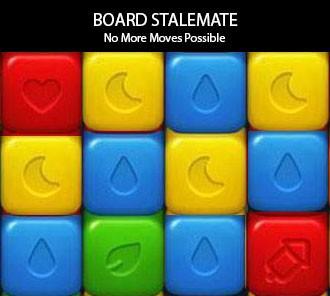
So, how to tackle this Achilles heel?
Successful collapse games try to minimise this stalemate situation by creating a lot of random “super gems” that give players the ability to potentially open up the board if moves are not possible, which may come down to level design and fine-tuning as well.
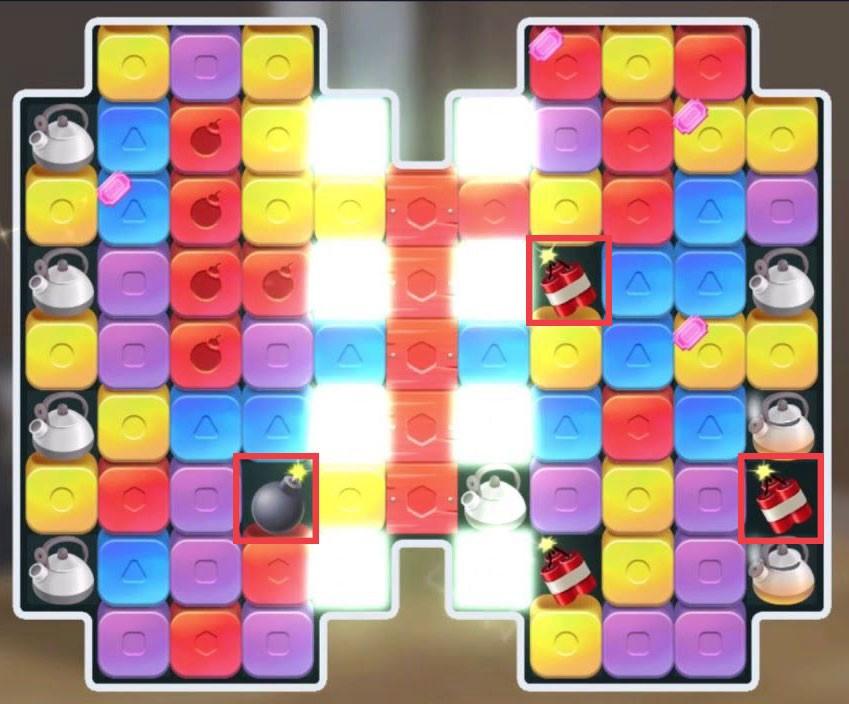
See, how some of the most successful Collapse games deal with this issue.
Blockbuster collapse games like Lily’s Garden uses a bigger board size. Toon Blast doesn’t typically introduce hard levels till players have surpassed 100+ levels, grounding players well into the mechanics before they hit a barrier.
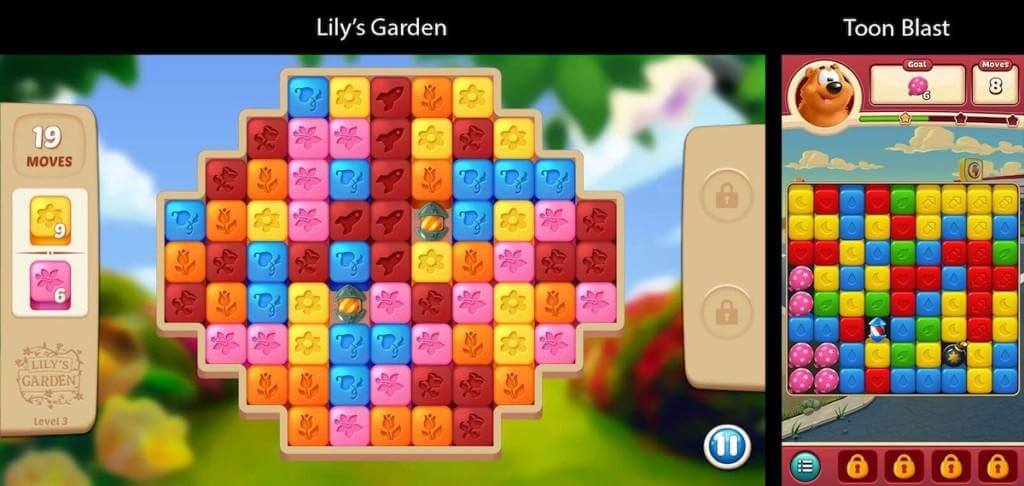
Property Brother’s, to a great extent, use a combination of these “stalemate” breakers to alleviate player friction:
1) Bigger board sizes
2) Generous with dropping random “Super Gems” like bombs, dynamites and barrels that can be used by players to blast big chunk of blocks. Players can also strategise, blasting many of these super gems next to each other creating more powerful blast combinations.
3) Hard levels typically appear only after crossing 60+ threshold
But…Did Storm 8 Ditch SWIPE for COLLAPSE with Property Brothers?
What makes SWIPE vs COLLAPSE debate even more interesting is that before launching Property Brothers, Storm 8 already had an identical game with the same decoration meta as Property Brothers home design – but with the SWIPE Match 3 mechanics.
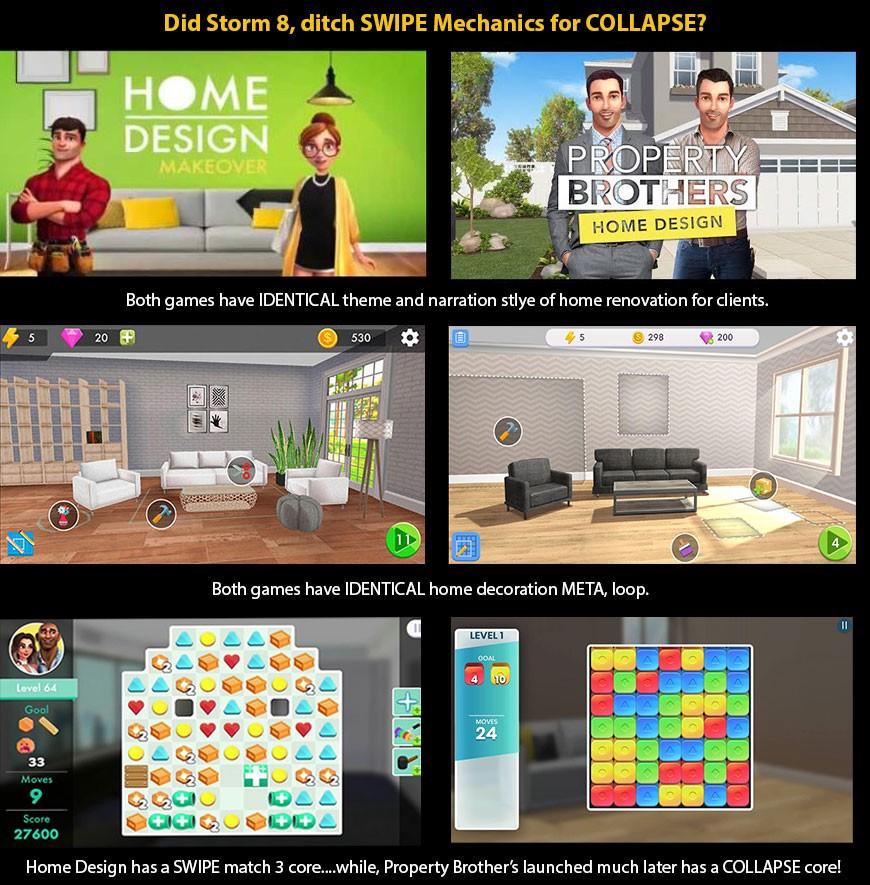
Property Brothers was launched with the exact same decoration meta & similar narrative style but the developers swapped SWIPE mechanics for COLLAPSE.
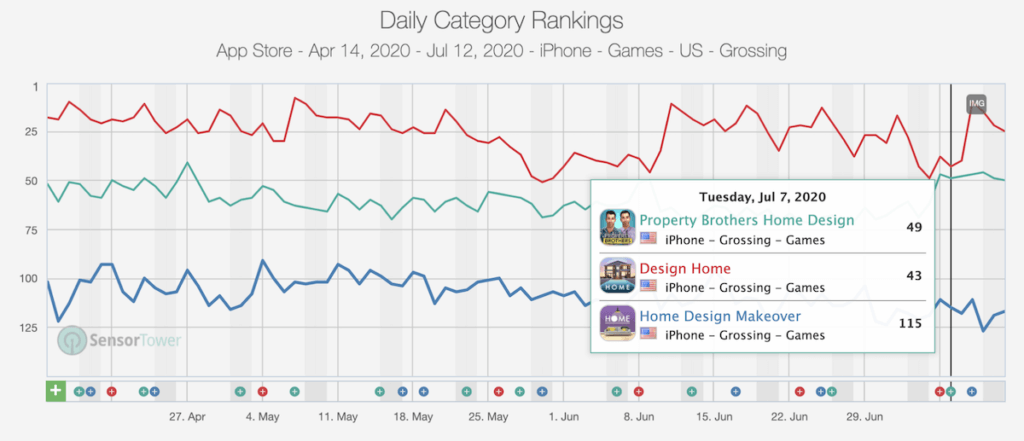
Source: Sensor Tower
Looking at the charts, it is clearly evident that the COLLAPSE avatar is finding way more success than its identical SWIPE cousin on the top grossing charts.
While the jury might not be out on COLLAPSE vs SWIPE debate, this is still a noteworthy observation from a developers point of view.
The META Loop & Events System
The meta is around interior & exterior decoration but there are some clever additions with a multi-currency approach.
Time limited event designs are super interesting because they extend interior decoration core gameplay to exterior events like pool parties, summer BBQ’s, wedding decorations, therebyadding more depth to (now commonplace) home decoration themes.

These events makes players feel smarter as they can relate to being a professional decorator compared to just being an amateur home decorator in core gameplay.
Time limited currencies (coins and time limited tokens) are 2 soft currencies, real clever additions, to how playing the events is a no brainer.
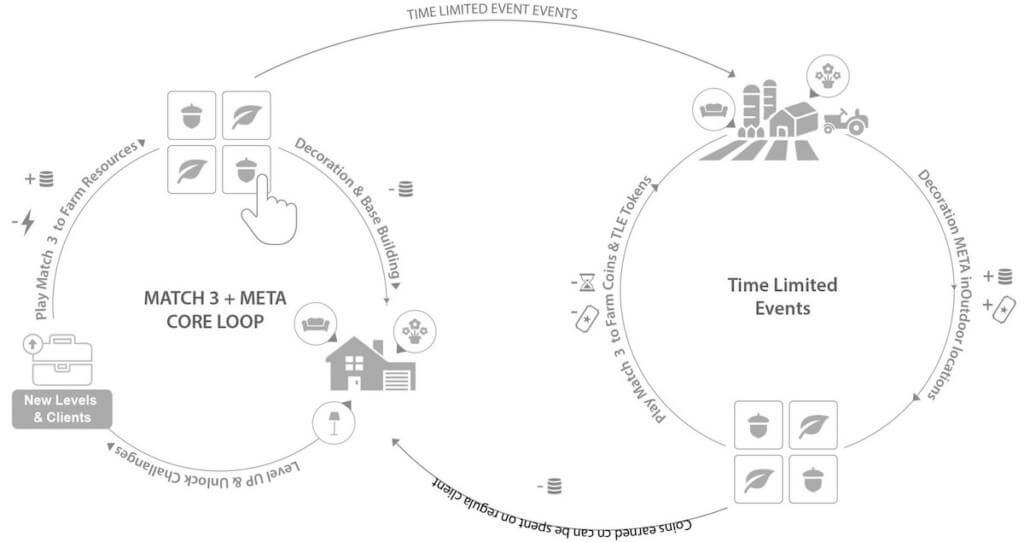
Regular coins can only be spent for interior decoration in regular game play (they cannot be used in events), while Time Limited tokens can be used exclusively only in an ongoing particular event. This means that events have dual value. Player is farming coins for regular gameplay while making progress on the active event front. This naturally incentivises players towards playing events as they can make good progress in regular decoration gameplay despite the outcome of the events themselves.
Conclusion & trends for Match 3 with Meta games 2020
- The barrier to entry is high in classic Match 3 as King has started pivoting its flagship Candy Crush Saga towards more meta goals driven franchise attempting to evolve the genre.
- On the Meta Match 3 side too, the barrier is going to be high due to early adopters like Playrix having adopted an assertive UA stand. Vertical integration strategy by AppLovin & recent M&A activity by Zynga (Peak Games) shows clear signs of a cash infusion for these small studios, thereby making them well-positioned to defend their turf.
- The key to gaining a foothold in this genre can be found in new audiences from other casual games and marrying the gameplay to Meta Match 3 like fashion, dress up, cooking, farming, narrative fiction, etc.
- Moving away from archaic single currency economies and reliance on consumables alone, to be better positioned to scale rewards as a meta-features pile-up.
Experimentation, finding new audiences and genre blending is going to be the key to evolving the genre & reaping rich rewards, despite high barriers to entry.
Update, December 01, 2020 — Prediction validation!
After publishing my two articles in April & July 2020, we are seeing a new Meta Match 3 “Project Makeover” launched in November climbing the top grossing charts (#12), combining the meta elements of Fashion, Make up, Dress up and Interior Decoration and finding great success so far appealing to audiences from other casual genre as predicted in this article series. (Looking forward to how it fares, post launch steam!)

More deep dives will be done in subsequent part of this series, stay tuned! If you want to tell us what you would like to see in future posts from Om, please take this 45 seconds survey HERE!
If you liked this post, please feel free to check out Om’s other game deconstructs at https://www.uxreviewer.com/ or get in touch for consulting queries. Feel free to connect with me for future articles.


